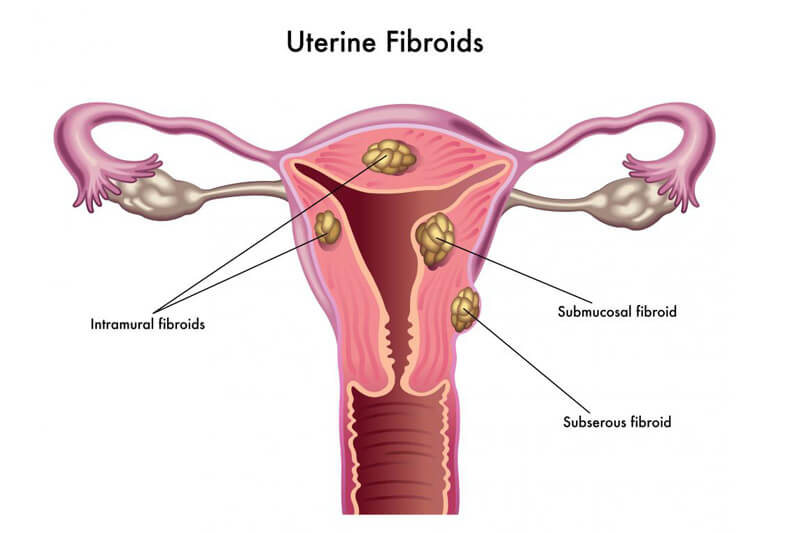Fibroids and Uterine Abnormalities

The Fibroid Treatment Collective. Image source: Types of Fibroid Tumors – What Do Those Names Mean? Accessed via https://fibroids.com/blog/health-information/types-of-fibroid-tumors-what-do-those-names-mean/
Fibroids are very common in women of reproductive age with up to 80% of women experiencing fibroids during their lifetime. Fibroids are benign uterine growths, which may affect fertility in the uterine wall (intramural), on the outer surface of the uterus (subserosal) and protruding into the cavity of the uterus (submucosal)
Many women are asymptomatic (have no symptoms) from their fibroids. The most common symptoms related to fibroids are abnormal uterine bleeding, and pressure, because of the size and position and pain, depending on the location and size. Our fertility specialist may prescribe medication or perform surgery to reduce menstrual blood flow, lessen or eliminate pain and improve fertility.
Signs & Symptoms of Uterine Fibroids
Fibroids, even large ones, can be present without any symptoms.
However, they can also cause a variety of symptoms depending on their size, location and the absence or presence of complications such as torsion (twisting) or degeneration (fibroid grows to an extent that it starts running out of its blood supply).
The most common symptoms are heavy cyclical menstrual bleeding (menorrhagia) accompanied by menstrual pain (dysmenorrhea).
Sometimes, especially when a fibroid protrudes into the uterine cavity, it can cause erosion of the endometrial lining and produce irregular or continuous bleeding (menometrorrhagia).
Other possible symptoms include pain with deep penetration during intercourse (dyspareunia), bladder irritability, rectal pressure, constipation and painful bowel movements (dyschezia).

How Do Fibroids & Uterine Abnormalities Affect Fertility
Fibroids and uterine abnormalities may play a role in hampering a couple’s ability to conceive. If the fibroids are in the uterine cavity or push on the fallopian tubes, they can affect a woman’s fertility. However, it is unclear whether fibroids in the uterine muscle affect fertility if they do not directly influence the movement of sperm, egg, or embryo.
- Changes in the position of the cervix (the vaginal opening to the womb) from the fibroids above may affect the number of sperm that can travel through the cervix.
- Changes in the shape of the uterus can interfere with sperm movement.
- Changes in the uterine muscle prevent the movement of sperm or embryo.
- Inflammation in the wall of the uterine cavity can affect implantation.
- Effects on the blood flow to the uterine cavity where the embryo would implant.
- Blockage of the fallopian tubes by the fibroids.
- The egg and tube are separated by fibroids, therefore, hindering its way into the tube.
Diagnosis of uterine fibroids
Sizable fibroids are usually easily identified by simple vaginal–pelvic bimanual examination. However, even the smallest fibroid can be identified by transvaginal ultrasound.
Sometimes it is difficult to tell if a fibroid is impinging on the endometrial cavity. In such cases, a hysteroscopy (where a telescope-like instrument, is inserted via the vagina into the uterine cavity) or a hydrosonogram (where saltwater distends the uterine cavity, allowing for examination of its contour and inner configuration) can help distinguish between intramural and submucosal fibroids.
Magnetic Resonance Imaging (MRI) can be used to distinguish between fibroid tumors and a related condition called adenomyosis, in which diffuse of the endometrium is found within the myometrium.
Medical treatment of uterine fibroids
The growth of fibroid tumors is estrogen-dependent. When a woman enters menopause and stops producing female hormones, fibroids tend to shrink in size.
The most common of these is treatment with a medication such as leuprolide acetate (Lupron), which shut off the communication of the brain with the ovaries, preventing hormone production.
However, this type of medication can only be taken for a limited period (usually 6 months) and once the medication is stopped the fibroids will usually regain their original size within a few months.
Therefore the medication is only a “temporary fix”; used mostly to decrease the size of large fibroids in order to make their ultimate surgical removal easier or to help a woman bridge the gap until spontaneous menopause sets in.
Surgical treatment of uterine fibroids
Fibroids may interfere with the implantation of a developing embryo. Our fertility specialist would usually discuss the treatment option following a diagnosis and ultrasound.
If the fibroid is within the cavity of the uterus then a hysteroscopy may be required. If the fibroid is within the muscle of the uterus or outside the uterus, the treatment may be by surgical removal – by open surgery or laparoscopy (keyhole surgery).
As a leading gynecologic practice, Footsteps To Fertility Centre offers women the most advanced treatments for fibroids and uterine abnormalities so they can find relief from symptoms such as irregular bleeding and reduce their chances of pregnancy complications.
Book Your
Appointment today!
Make an Appointment


